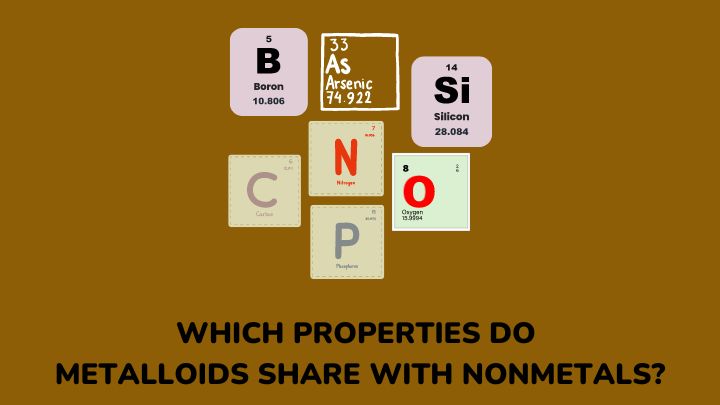Are metalloids more metals than nonmetals? Which properties do metalloids share with nonmetals?
If you think of the periodic table as a pie chart, there are intersecting arcs where metals of different kinds overlap. They seem to be alike, but they have their unique differences. You find this with metals or nonmetals and metalloids.
Metalloids take their characteristics from both metals and nonmetals. However, the focus of this article is a comparison of metalloids and nonmetals. I’ll discuss the similar properties they share and the differences that set them apart.
What are nonmetals?
Nonmetals are elements that lack any trace of metallic properties. On a broad scale, they include elements in groups 13-18. However, under this classification, there are metalloids, halogens, noble gases, and recognized nonmetals such as carbon, oxygen, and nitrogen.
The majority of the nonmetals are gases at room temperature. Some are liquids and some are solids. Nonmetals are brittle, non-ductile, and non-malleable. They are also poor conductors of heat and electricity, which is why they are best used for the production of insulating wires.
Nonmetals can form ionic or covalent bonds, depending on the elements they react with. When they react with metals, they gain electrons lost from the metals and form ionic bonds. When nonmetals react with fellow nonmetals, they share electrons and form covalent bonds.
What are metalloids?
Metalloids are a group of seven elements that have metallic and nonmetallic properties. They are boron (B), silicon (Si), germanium (Ge), arsenic (As), antimony (Sb), tellurium (Te), and polonium (Po).
They belong to different groups and periods on the periodic table but are located between nonmetals and poor metals (or post-transition metals). Metalloids have the physical appearance of metals but tend to behave more like nonmetals.
They are more thermally or electrically conductive than nonmetals, but not like metals. They are also more brittle than metals but not as brittle as nonmetals that are solids at room temperature.
Metalloids are less dense than metals but denser than nonmetals. They require less heat than metals and more heat than nonmetals to convert from a solid to a liquid or gas.
Metalloids and nonmetals are more brittle than metals and not lustrous. They are both poor conductors of heat and electricity.
Also, metalloids and nonmetals react with oxygen to form acidic oxides. Metalloids have a higher tendency to form anions like nonmetals. More so, both types of elements can have positive or negative oxidation numbers, unlike metals which are nearly always positive.
Furthermore, metalloids and nonmetals form volatile covalent compounds with halogens. These compounds are generally soluble in organic solvents and are usually partly or completely hydrolyzed.
Differences between metalloids and nonmetals?
- Metalloids are located in the s and p blocks while nonmetals are found only in the p block
- Nonmetals show no or a negligible degree of metallic properties, but metalloids tend to behave a lot like metals
- Nonmetals show no luster whereas metals have the lustrous appearance of metals
- Metalloids have an intermediate level of electronegativity and ionization energy while nonmetals are highly electronegative and have high ionization energies
FAQs
Do metalloids react with nonmetals?
Yes, they do. Metalloids react with nonmetals to form covalent compounds. Metalloids can behave like metals and nonmetals.
Are metalloids poor metals?
Metalloids are different from poor metals. The poor metals are members of the post-transitional metals which have unpaired d electrons, whereas metalloids are elements that share characteristics with metals and nonmetals.
Are nonmetals better insulators than metalloids?
Yes, nonmetals are better insulators than metalloids. Their inability to conduct heat, which may look like a weakness before metals makes them the ideal materials for making insulating wires. The atoms in nonmetals are tightly bound together and do not readily move. This also explains their resistance.
What is the reactivity among metalloids?
The reactivity of a metalloid depends on the properties of the other elements in reaction with it. For instance, tellurium is highly reactive with sulfur and selenium, and boron shows high reactivity with fluorine and oxygen.
Conclusion
Metalloids and nonmetals are two different classifications of elements of the periodic table. However, due to their position on the periodic table and their partially filled electron shells, they exhibit both metallic and non-metallic properties.
Among these are their brittleness, dull appearance, and poor conduction of heat and electricity which they share with nonmetals. This does not make them qualify as nonmetals because they still retain their metallic properties.
Also, learn more about the alkaline earth metals – their properties, reactions, and applications.
Thanks for reading.
